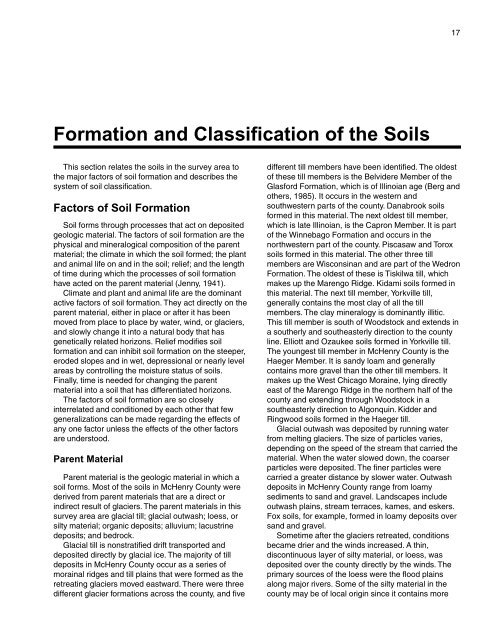Soil Survey of McHenry County, Illinois Part I - Soil Data Mart
Soil Survey of McHenry County, Illinois Part I - Soil Data Mart
Soil Survey of McHenry County, Illinois Part I - Soil Data Mart
You also want an ePaper? Increase the reach of your titles
YUMPU automatically turns print PDFs into web optimized ePapers that Google loves.
Formation and Classification <strong>of</strong> the <strong>Soil</strong>s<br />
This section relates the soils in the survey area to<br />
the major factors <strong>of</strong> soil formation and describes the<br />
system <strong>of</strong> soil classification.<br />
Factors <strong>of</strong> <strong>Soil</strong> Formation<br />
<strong>Soil</strong> forms through processes that act on deposited<br />
geologic material. The factors <strong>of</strong> soil formation are the<br />
physical and mineralogical composition <strong>of</strong> the parent<br />
material; the climate in which the soil formed; the plant<br />
and animal life on and in the soil; relief; and the length<br />
<strong>of</strong> time during which the processes <strong>of</strong> soil formation<br />
have acted on the parent material (Jenny, 1941).<br />
Climate and plant and animal life are the dominant<br />
active factors <strong>of</strong> soil formation. They act directly on the<br />
parent material, either in place or after it has been<br />
moved from place to place by water, wind, or glaciers,<br />
and slowly change it into a natural body that has<br />
genetically related horizons. Relief modifies soil<br />
formation and can inhibit soil formation on the steeper,<br />
eroded slopes and in wet, depressional or nearly level<br />
areas by controlling the moisture status <strong>of</strong> soils.<br />
Finally, time is needed for changing the parent<br />
material into a soil that has differentiated horizons.<br />
The factors <strong>of</strong> soil formation are so closely<br />
interrelated and conditioned by each other that few<br />
generalizations can be made regarding the effects <strong>of</strong><br />
any one factor unless the effects <strong>of</strong> the other factors<br />
are understood.<br />
Parent Material<br />
Parent material is the geologic material in which a<br />
soil forms. Most <strong>of</strong> the soils in <strong>McHenry</strong> <strong>County</strong> were<br />
derived from parent materials that are a direct or<br />
indirect result <strong>of</strong> glaciers. The parent materials in this<br />
survey area are glacial till; glacial outwash; loess, or<br />
silty material; organic deposits; alluvium; lacustrine<br />
deposits; and bedrock.<br />
Glacial till is nonstratified drift transported and<br />
deposited directly by glacial ice. The majority <strong>of</strong> till<br />
deposits in <strong>McHenry</strong> <strong>County</strong> occur as a series <strong>of</strong><br />
morainal ridges and till plains that were formed as the<br />
retreating glaciers moved eastward. There were three<br />
different glacier formations across the county, and five<br />
17<br />
different till members have been identified. The oldest<br />
<strong>of</strong> these till members is the Belvidere Member <strong>of</strong> the<br />
Glasford Formation, which is <strong>of</strong> Illinoian age (Berg and<br />
others, 1985). It occurs in the western and<br />
southwestern parts <strong>of</strong> the county. Danabrook soils<br />
formed in this material. The next oldest till member,<br />
which is late Illinoian, is the Capron Member. It is part<br />
<strong>of</strong> the Winnebago Formation and occurs in the<br />
northwestern part <strong>of</strong> the county. Piscasaw and Torox<br />
soils formed in this material. The other three till<br />
members are Wisconsinan and are part <strong>of</strong> the Wedron<br />
Formation. The oldest <strong>of</strong> these is Tiskilwa till, which<br />
makes up the Marengo Ridge. Kidami soils formed in<br />
this material. The next till member, Yorkville till,<br />
generally contains the most clay <strong>of</strong> all the till<br />
members. The clay mineralogy is dominantly illitic.<br />
This till member is south <strong>of</strong> Woodstock and extends in<br />
a southerly and southeasterly direction to the county<br />
line. Elliott and Ozaukee soils formed in Yorkville till.<br />
The youngest till member in <strong>McHenry</strong> <strong>County</strong> is the<br />
Haeger Member. It is sandy loam and generally<br />
contains more gravel than the other till members. It<br />
makes up the West Chicago Moraine, lying directly<br />
east <strong>of</strong> the Marengo Ridge in the northern half <strong>of</strong> the<br />
county and extending through Woodstock in a<br />
southeasterly direction to Algonquin. Kidder and<br />
Ringwood soils formed in the Haeger till.<br />
Glacial outwash was deposited by running water<br />
from melting glaciers. The size <strong>of</strong> particles varies,<br />
depending on the speed <strong>of</strong> the stream that carried the<br />
material. When the water slowed down, the coarser<br />
particles were deposited. The finer particles were<br />
carried a greater distance by slower water. Outwash<br />
deposits in <strong>McHenry</strong> <strong>County</strong> range from loamy<br />
sediments to sand and gravel. Landscapes include<br />
outwash plains, stream terraces, kames, and eskers.<br />
Fox soils, for example, formed in loamy deposits over<br />
sand and gravel.<br />
Sometime after the glaciers retreated, conditions<br />
became drier and the winds increased. A thin,<br />
discontinuous layer <strong>of</strong> silty material, or loess, was<br />
deposited over the county directly by the winds. The<br />
primary sources <strong>of</strong> the loess were the flood plains<br />
along major rivers. Some <strong>of</strong> the silty material in the<br />
county may be <strong>of</strong> local origin since it contains more

















